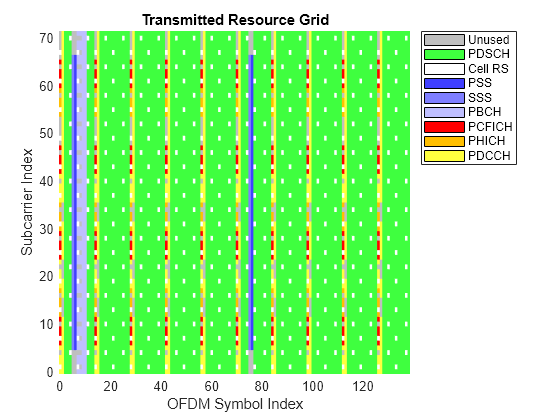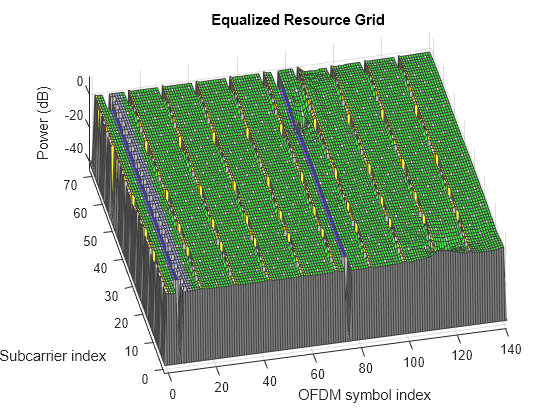Transmit-Receive Chain Processing
Transmit-Receive Chain
This example shows how to implement an LTE transmit and receive chain, as shown in this figure.

Generate an E-UTRA test model (E-TM) configuration. Use this configuration to generate the waveform and populate the resource grid.
enb = lteTestModel('1.1','1.4MHz'); [txwave,txgrid,info] = lteTestModelTool(enb);
Plot a graphical representation of the transmit resource grid.
hPlotDLResourceGrid(enb,txgrid);
title('Transmitted Resource Grid');
The figure shows a resource grid populated with E-TM 1.1 resource elements.
Simulate transmission through a fading channel propagation model.
channel.ModelType = 'GMEDS'; channel.DelayProfile = 'EVA'; channel.DopplerFreq = 70; channel.MIMOCorrelation = 'Medium'; channel.NRxAnts = 1; channel.InitTime = 0; channel.InitPhase = 'Random'; channel.Seed = 17; channel.NormalizePathGains = 'On'; channel.NormalizeTxAnts = 'On'; channel.SamplingRate = info.SamplingRate; channel.NTerms = 16; rxwave = lteFadingChannel(channel,[txwave;zeros(25,1)]);
Plot the time-varying power of the received waveform.
figure('Color','w'); helperPlotReceiveWaveform(info,rxwave);

This plot shows the waveform power variation over time.
Perform frame synchronization.
offset = lteDLFrameOffset(enb,rxwave); rxwave = rxwave(offset:end,:);
Perform OFDM demodulation.
rxgrid = lteOFDMDemodulate(enb,rxwave);
Create a surface plot showing the power of the received grid for each subcarrier and OFDM symbol.
figure('Color','w'); colors = hIdentifyDLChannels(enb,rxgrid); % Obtain resource grid colorization hPlotResourceGrid(abs(rxgrid),colors); title('Received Resource Grid');

This plot shows the received grid power.
Estimate the channel and noise.
cec.PilotAverage = 'UserDefined'; cec.FreqWindow = 9; cec.TimeWindow = 9; cec.InterpType = 'Cubic'; cec.InterpWindow = 'Centered'; cec.InterpWinSize = 3; [hest,nest] = lteDLChannelEstimate(enb,cec,rxgrid);
Create a surface plot showing the magnitude of the channel estimate for each OFDM symbol across the subcarriers.
figure('Color','w'); helperPlotChannelEstimate(hest);

This figure shows an estimate of channel magnitude frequency response.
Finally, perform minimum mean-square error (MMSE) equalization on the received grid.
eqgrid = lteEqualizeMMSE(rxgrid,hest,nest);
Create a surface plot of the power of the equalized resource grid, in dB.
figure('Color','w'); colors = hIdentifyDLChannels(enb,eqgrid); % Obtain resource grid colorization hPlotResourceGrid(abs(eqgrid),colors); title('Equalized Resource Grid');

As can be seen the equalization flattened the power response across the resource grid.
See Also
lteTestModel | lteTestModelTool | lteFadingChannel | lteDLFrameOffset | lteOFDMDemodulate | lteDLChannelEstimate | lteEqualizeMMSE